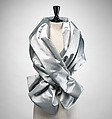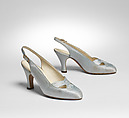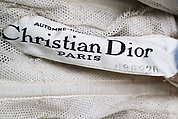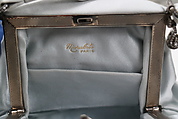"Du Barry" evening ensemble
(a, b) House of Dior French
Designer Christian Dior French
(c, d) Delicata French
Not on view
When Christian Dior founded his eponymous couture house, he envisioned a maison that would confirm France’s supremacy in the luxury fashion trades, a position it had cultivated since the late seventeenth century. The ideal of femininity he presented in his first collection, in 1947, took inspiration from past eras that represented France’s creative and technical dominance of the fashion industry. The eighteenth century, Second French Empire, and Belle Époque continued to provide inspiration for Dior through his last collection in 1957, when this dress was shown under the name “Du Barry,” after King Louis XV’s mistress. The era of its namesake is invoked in the prominent décolletage, domed outline, coquettish bows, and skirt draping, which imitates the appearance of an eighteenth-century open robe and petticoat. The gown’s original wearer, Elizabeth Parke Firestone, an enthusiastic collector of eighteenth-century French decorative arts, likely appreciated these references to a favored artistic period.
Regular clients of a couture house were frequently sent sketches of the latest designs along with swatches for review. The design sketch for “Du Barry” was sent to Firestone following the presentation of the autumn/winter 1957–58 collection. A demanding client, Firestone often requested that the house source specific fabrics or make alterations to the original design according to her preferences. In this case, she was evidently pleased with the design as it was presented to her; she not only accepted the proposed fabric but ordered the evening dress with only a minor change to the neckline.
Due to rights restrictions, this image cannot be enlarged, viewed at full screen, or downloaded.
This artwork is meant to be viewed from right to left. Scroll left to view more.









